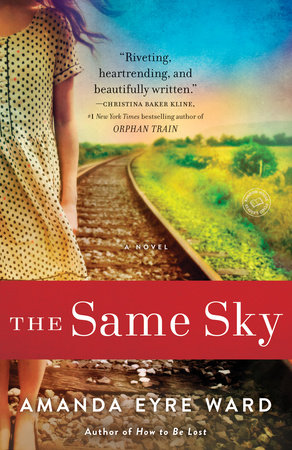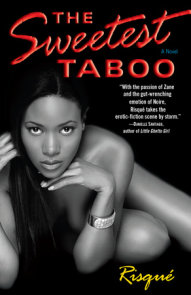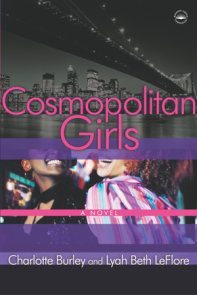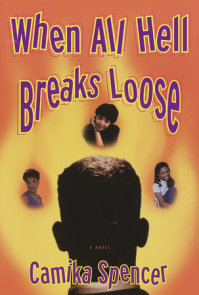READERS GUIDE
A Conversation between Amanda Eyre Ward and Christina Baker KlineChristina Baker Kline is a novelist, nonfiction writer, and editor. She is the author of the #1 New York Times bestselling Orphan Train, a novel about an unlikely friendship between a seventeen–year–old Penobscot Indian foster child and a ninety–one–year–old Irish American widow who was one of several hundred thousand orphans to be transported from crowded East Coast cities to foster homes in the Midwest during the late nineteenth and early twen-tieth centuries. Christina’s other novels include Bird in Hand, The Way Life Should Be, Desire Lines, and Sweet Water.
Christina Baker Kline: I read The Same Sky six months ago and still carry it around in my head. Your writing is vivid and immediate; you tell a complex story in such an accessible way. The reason I think it’s so memorable is that you build scenes with vivid specific details, use humor as a valve, and write about your characters with compassion and depth. They are fully human. Tell me—-how did you pull that off?
Amanda Eyre Ward: I know that some writers start with a plot or setting, but for me, everything begins with my characters. I see them in my imagination, and follow them wherever they want to take me. (I have learned from experience that trying to force them to go where I want them to is a futile and wasted effort.)
I spend a lot of time taking care of my children and not getting words on the page, so I try to use this time to gather details about my characters: If I’m grocery shopping, I ask myself, What would Alice buy for dinner? If I’m driving to a birthday party, I think, Which street might lead to Evian’s house?
I’m a huge reader, and if I’m invested in a character, I won’t put down the book. So when I wanted to write about unaccompanied minors and their journey to the U.S. border, I knew that Carla’s character was key. Luckily, her voice came to me. Carla’s voice mirrors many of the unaccompanied minors I met: feisty, funny, brave, hopeful.
CBK: How did you come to be interested in unaccompanied minors?
AEW: I had been working on my fifth novel for two and a half years when my agent told me it was terrible. For months, I stumbled around in a haze of misery. During the hours I’d previously spent working, I read everything I could get my hands on.
I read Enrique’s Journey, the nonfiction account of a boy traveling from Honduras to reach his mother in America, after reading a profile of Sonia Nazario in the alumni magazine of Williams College, which we both attended. The book grabbed me immediately—-Nazario’s research was dangerous and important, and I wanted to read more about children like Enrique. I searched the Web for stories, transfixed by kids my own children’s ages who were walking away from everything they knew to try to reach their mothers and fathers in America. As I tucked him in at night, I tried to visualize my own ten–year–old son bringing my six–year–old (and one–year–old!) on such a dangerous trek. It was impossible to imagine.
I met Alexia Rodriguez, whose organization, Southwest Key, runs many of the shelters at the border. Alexia brought me to Brownsville, Texas, where she introduced me to unaccompanied minors and I spoke to them about writing.
I also talked to the children about why they had left, what horrors they had faced along the way, and what they hoped to find. One girl told me about watching her friend being attacked by an alligator and being forced by her –coyote to leave the ailing girl behind. I met a five–year–old whose parents had left him when he was an infant. They lived in New Jersey, and he was due to be reunited with them in the morning. I heard about boat trips, plane trips, and how hard it is to sleep on The Beast.
And I met children who had been assaulted. Some of the girls were pregnant—-their eyes dark and flat, their hair clean from the shelter showers. They wore pink sweatsuits and told me stories I will never forget.
That night, I lay awake, unable to sleep. It was excruciating to think about the kids just a few miles away. They were so brave and so alone. They were filled with a faith I envied, the belief that God was with them and that they would find peace (and be loved) in America. I tried to think of what to do to help them but came up with nothing.
In the middle of the night, I heard a voice, the first sentence of a new novel: My mother left when I was five years old. And though I never thought I’d hear the voice of a young Honduran girl in my imagination, I listened. In the morning, the entire arc of the novel was clear to me. I could get one fictional girl to her mother, and that was a small something.
CBK: Since Carla’s voice and story arc came to you so clearly, why did you decide to incorporate Alice into her story?
AEW: During my research, I watched some videos of Father Alejandro Solalinde Guerra, who runs a shelter for migrants in Ixtepec, Mexico. (Carla and Junior come to this shelter in the book.) Father Solalinde Guerra said something that resonated deeply with me: these children have the spiritual capital that Americans need. I was very struck by this thought, and found it to be true. The children I met at the border, who literally have no material goods, have a sense of faith and hope—-a belief that they are and will be taken care of—-that I am often lacking.
I wanted to create a character who has the trappings of the American Dream—-a successful business, a house, even a kind and supportive husband—-but who yearns for something else, something deeper. She needs the spiritual capital that Carla possesses in abundance.
The main characters in your novel Orphan Train come from very different backgrounds as well. In your mind, how do you see their stories as fitting together?
CBK: Similar to what you were saying about how Carla’s character came to you, I find that when you write novels you go on instinct much of the time. As I began writing about Molly, a seventeen–year–old Penobscot Indian foster child, believe it or not I didn’t immediately notice parallels to Vivian, a wealthy ninety–one–year–old widow. But as I wrote my way into the narrative I could see that in addition to some biographical parallels—-both characters have dead fathers and institutionalized mothers; both were passed from home to home and encountered prejudice because of cultural stereotypes; both held onto talismanic keepsakes from family members—-they are psychologically -similar. For both of them, change has been a defining principle; from a young age, they had to learn to adapt, to inhabit new identities. They’ve spent much of their lives minimizing risk, avoiding complicated entanglements, and keeping silent about the past. It’s not until Vivian—-in answer to Molly’s pointed questions—-begins to face the truth about what happened long ago that both of them have the courage to make changes in their lives.
AEW: As I read Orphan Train, I was struck with the thought that unaccompanied minors have a great deal in common with the children you write about. Do you think?
CBK: I do. There are so many parallels in these stories of the orphan train riders and the border kids. One thing that I’ve learned in my research is that every immigrant group that comes to this country faces some kind of hazing process. When people are assimilated, they tend to forget that their ancestors (or even near relatives) were once poor, dispossessed, and alien. These stories force us to face that fact.
AEW: I finished reading Orphan Train, closed the book, and continued to think about the strength those children found in the face of such profound disappointment. The unaccompanied minors I met were also incredibly courageous. . . . I hope that readers can listen to Carla’s story and be inspired.
Questions and Topics for Discussion
1. At the beginning of the novel we learn that Carla’s mother left for Texas when Carla was just five years old. How does that experience shape Carla, for better or for worse?
2. Carla and Alice come from very different backgrounds, but their lives are ultimately connected. What qualities or personality traits do they share?
3. Carla’s journey to Texas is life-threatening and heartbreaking, but she never gives up. Where do you think she derives her strength and faith from?
4. Jake becomes very angry about the way Alice handles the situation with Evian. Do you think his anger is justified? Why or why not?
5. What do you think Alice learns from her relationship with Evian? How does it contribute to her broader outlook?
6. Through the different experiences of Alice, Jane, and Carla, the author explores three unique attitudes toward motherhood. What resonated with you about the experiences of all three characters as they reflected on the idea of motherhood and its role in their lives?
7. At various points in the novel, Alice and Jake disagree about whether or not they should continue trying to adopt. What would you do if your spouse told you that he or she couldn’t take the heartbreak of any more failed adoptions?
8. Despite her best efforts to protect him, Carla is ultimately left with no choice about what to do with Junior. Do you agree with her decision? Can you imagine what you might have done in her shoes?
9. After Alice and Jane lose their mother to ovarian cancer, and considering Alice’s own battle with breast cancer, Alice can’t understand why Jane still refuses to find out if she’s at risk as well. Jane maintains that she’d rather live freely with risk than miss out on certain parts of life. Which sister do you agree with? Why?
10. Throughout the novel the narrative alternates between Carla’s perspective and Alice’s. Was there ever a point when you wished you could find out what was going on with the other character? When did this happen and why do you think you felt such a strong pull?
11. Were you surprised by how things turned out for Carla and Alice? Why or why not?
12. The issue of undocumented immigration is clearly essential to the plot of The Same Sky, and is a hugely polarizing part of the American experience today, but it doesn’t overpower the other themes in the novel. How do you think the author achieved that balance?
13. In addition to undocumented immigration, The Same Sky deals with issues of love, motherhood, personal health, rape, adoption, economic inequality, and many more. Of all the themes addressed in the novel (whether explicitly or implicitly), which was the most thought provoking for you? Why?






















